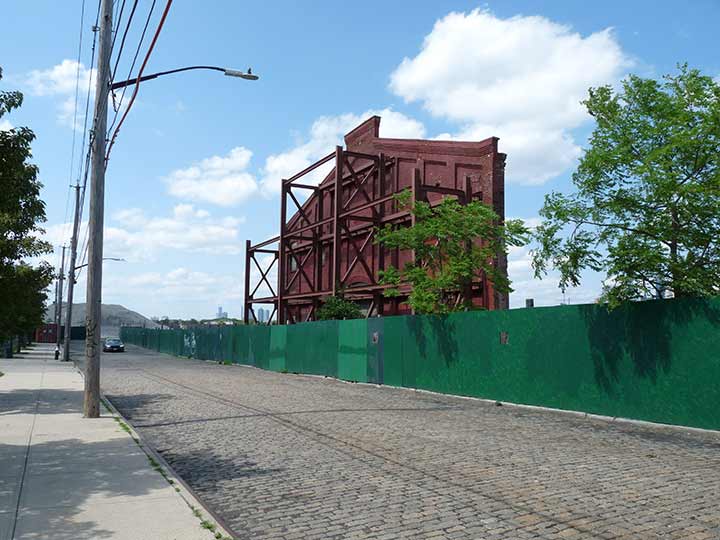
RED HOOK is usually fairly decent at preserving its relics (despite the lack of action by the Landmarks Preservation Commission), with the exception of the dry docks since replaced by the IKEA furniture complex on Beard Street. When I am in the area, I either stop in for some Swedish meatballs, that is, if I’m not in the mood for some Steve’s Key Lime Pie. (I used to buy furniture from the IKEA complex in Hicksville, but I’m nobody’s carpenter and forcing me to build furniture myself usually results in jury-rigging). However, here’s one relic that got away.
Fortunately I covered the Lidgerwood Building at Coffey and Ferris streets, opposite the Louis Valentino Pier, back in 2019, when most of it was still standing. It was a factory owned by the Lidgerwood Manufacturing Company, a foundry used to build equipment (engines, boilers, conveying machines) used in the construction of the Panama Canal and Croton Reservoir. The company was founded in 1873, and their Red Hook complex was built in 1882. Edison took over in 1926. In recent years, its evocative appearance has been used in TV and movie shoots, such as in Boardwalk Empire. Once again, the Indispensable Maggie Blanck has the complete scoop, which includes several photos of the interior…
The basilica form brick construction with central large doorway, side windows, a bulls eye window, clerestory widows, skylights, corbeled brickwork near the roof line and pilasters, was typical of the late nineteenth century industrial work shops in the American Arch Style. I have read that the oculus was included for light and ventilation. How much more light and ventilation could it have afforded in a building full of windows? The oculus was a common feature of industrial buildings of this period. I believe it is a nod to the oculi and Rose widows of the basilica churches of Europe and was part of the iconography of the American Round Arch Style. [Maggie Blanck]
Unfortunately Maggie’s Red Hook pages are down as I write this, and I hope she restores them at some time.
United Parcel Service purchased the site in 2019 and in May proceeded to tear down the building with the exception of a wall facing Coffey Street, shown here. Five years later, the site remains empty except for the wall. The COVID-19 pandemic likely delayed any further construction on the site, but in New York it’s standard procedure for property where a teardown has taken place to remain fallow for several years.
As always, “comment…as you see fit.” I earn a small payment when you click on any ad on the site. Take a look at the new JOBS link in the red toolbar at the top of the page on the desktop version, as I also get a small payment when you view a job via that link.
11/7/24


2 comments
Give them some credit for keeping that facade and maybe building it into whatever’s planned there.
I was once told by a contractor who did a lot of work in the south Bronx for father Gigante that if the building was not completely demolished, with one wall left standing and that wall was incorporated in the new construction the job qualified as a renovation rather than a new construction resulting in the need for different types (and cheaper) permits.